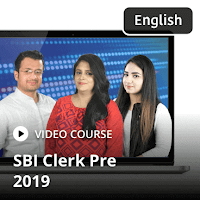SBI Clerk English Questions: 17th June
State Bank of India’s most awaited clerk exam is just 6 days away. All the practice and revision is essential for the final touches. English being the subject that gives chills to most of the students need attention on a daily basis. Fight the fear of English with SBI Clerk Crash Course Night Class quiz. These quizzes will enable aspirants to have the experience about what type of question can be asked in the actual examination, and you can be fully prepared for the D- day. Here is today’s quiz on the English Language to help you assess your preparation for SBI Clerk Prelims 2019. Keep Practicing. All the best.
Directions (1-5): Read the following passage carefully and answer the questions given below it. Certain words are given in bold to help you locate them while answering some of the questions.
This year’s UNDP Human Development Report doesn’t, as usual, present a pretty picture so far as India is concerned. India ranks 126 in the human development index (HDI) among 177 countries. Placed in the lower half of ‘medium human development’ countries, India is 10 places ahead of Bangladesh and only three ahead of Myanmar.
Though it is India’s abysmal rank that grabs one’s attention — particularly in the context of the euphoria about India’s economic growth — the UNDP report is best used to chart the performance of the state. The HDI, brainchild of economist Mahbubul Haq, was developed to track human welfare as opposed to material wealth which is measured by GDP. It is a measure based on three dimensions of human development — life expectancy, literacy and standard of living. India’s show¬ing on all three counts is far from inspiring. Even if India is compared to developing countries in Asia it fares poorly. Indonesia, for example, is streets ahead with an adult literacy rate of 90 per cent as compared to 61 per cent in India; Indonesia’s life expectancy is 67.2 to India’s 63.6; and the population who survive on $1 a day is 7.5 per cent in Indonesia as opposed to 34.7 per cent in India. There are several other countries in the region such as Thailand, Iran and Vietnam that are way ahead of India on all these indices.
The uninspiring figures for India must be seen in the light of state spending on health and education. The health expenditure of the state was 1.2 per cent of GDP, which is at par with Indonesia and Bangladesh, but far lower than medium-development countries such as China or Vietnam. On the education front, the public spending on education in India at 3.3 per cent of GDP is higher than that in Indonesia, but lower than other developing countries like Mexico. It is not all gloom and doom for India though. India’s dependence on foreign aid has come down over the last 15 years. Foreign development assistance now stands at 0.1 per cent of GDP as compared to 0.4 per cent in 1990. The figures for China and Vietnam stand at 0.1 and 4 per cent respectively. India does not fare too badly either on the Gini index, which measures inequality on a scale where 0 represents perfect equality and 100 perfect inequality. India scores 32.5 on the Gini. Which compares favourably with China’s 44.7 and Indonesia’s 37.0.
The picture that emerges is that of an Indian state that channels inadequate funds into health and education, which is reflected in India’s poor showing on the HDI. A few obvious conclusions can be drawn from this.
One, India’s aspirations of becoming a global power must be taken with more than a pinch of salt. Two, the Indian state hasn’t got its priorities right. This can be seen from government spending on defense, which is nearly the same as that on education and more than double that on health. Three, even when government does allocate funds there is no guarantee that it reaches the intended beneficiaries. As Rajiv Gandhi once remarked, out of every rupee spent on development only 17 paise actually reached its target.
The failure of the state machinery in India is an old story. But it touches a different chord at a time when there are breathless predictions about India, along with China, becoming the economic powerhouse of the world. It is apparent that the benefits of a consistently high level of growth do not automatically trickle down to the poor and translate into a better quality of life. But what does one do to ensure that education and health benefits percolate down to the most needy?
There are some who would like to believe that education and health should be left in private hands. This is a reflection of the increasing antipathy among certain sections towards the state. It also reflects a belief that India’s economic boom has happened despite the state. There could well be some truth in that. But it still begs the question as to why private players would take up projects such as health care and education for the poor where there is little or no chance of profit. There is no escaping the fact that education and health, along with law and order, remain responsibilities of the state.
Q1. Why does the UNDP's Human Development Report on India take one by surprise?
because India has been targeted in an unfair manner in this report
because amidst its sound economic growth India has fared badly in the area of human welfare
because India lags behind even Bangladesh and Myanmar in this report
because India's economic growth has not been considered in this report
None of these
Solution:
It is India's abysmal rank in the human development index that grabs one's attention, particularly in the context of the euphoria about India's economic growth.
Q2. According to the author, how can India improve its position on the HDI?
by pursuing its economic growth on a continuous basis
by allowing privatisation of essential services in the areas of health and education
by competing with lesser known countries like Indonesia, Bangladesh, Vietnam, etc
by setting its priorities right and spending adequately in the areas of human welfare
None of these
Solution:
Indian state channels inadequate funds into health and education, which is reflected in India's poor showing on the HDI. Therefore, the govt. has to set its priorities right and spend adequately in the above areas.
Q3. Which of the following seems to be 'true' in the context of the passage?
India's health expenditure as a proportion of its GDP is similar to that of Indonesia and Bangladesh.
Better economic growth of any region is bound to produce a better picture of its human welfare.
Indonesia is miles ahead of India in terms of human welfare and economic growth.
Government's allocation of funds for key areas is sure to bring desired results.
None of these
Solution:
The health expenditure of India was 1.2 percent of GDP, which is at par with Indonesia and Bangladesh.
Q4. Which of the following seems to be 'false' in the context of the passage?
India has tackled the issue of inequality better than China and Indonesia.
Better GDP does not ensure sound HDI for a nation.
Proper allocation of funds can certainly bring betterment in areas of human welfare.
Economic growth does not guarantee better quality of life for poor always.
None of these
Solution:
Even when government does allocate funds there is no guarantee that it reaches the intended beneficiaries. Thus it cannot guarantee betterment in areas of human welfare.
Q5. What perception makes some people favour the concept of privatisation of education and health services?
Due to the failure of the state in these areas, it is believed that only private sector can deliver rightly.
These areas are good avenues of business.
Private sector is better equipped to do justice to people.
In the age of globalisation all such areas should be freed from the clutch of government control.
None of these
Solution:
Last para contains the gist.
Directions (6-10): In the following questions, a sentence is given with four highlighted words. Choose the combination of words that mentions the words which are either misspelt or grammatically incorrect or contextually meaningless. If all the highlighted words are correct, choose option (E) i.e. “All are correct” as your answer choice.
Q6. Amidst the rising number of defaults by companies, the chief markets regulator is taking the fight to what it thinks is the enemy: ratings agencies.
defaults
companies
regulator
agencies
No Error
Solution:
No Error
Q7. EBI’s aggressive regulatory aproach seems to suggest a certain disappointment with credit rating agencies, which may not be unfounded.
aggressive
aproach
disappointment
credit
No Error
Solution:
Approach
Q8. For some time now, it’s been evident that the environment is in a state of utter ruen.
evident
environment
utter
ruen
No Error
Solution:
Ruin
Q9. Many children in elementary classrooms across India cannot read and write proficiently, as demonstrated on an annual basis by the Annual Status of Education Reports (ASER).
elementary
proficiently
demonstrated
Education
No Error
Solution:
No Error
Q10. Modasty is not a virtue of the media in the pixel age, in which preening is a 24x7 pastime. There is neither a demand for it from consumers, nor a supply of it from the .
Modasty
pastime
consumers
practitioners
No Error
Solution:
Modesty
Directions (11-15): In each of the questions given below a pharse/idiom is given in BOLD and five options are given below it. You have to choose the option which best describes the meaning of the phrase/idiom.
Q11. Whole nine yards
a wealthy person
A mysterious area
A long distance
Everything possible or available
None of these
Solution:
Whole nine yards: Everything possible or available
Q12. Cup of Joe
A cup with Joe printed on it
A cup of coffee
A cup of tea
A difficult situation for someone
None of these
Solution:
Cup of Joe: an American nickname for a cup of coffee.
Q13. A dime a dozen
To make future plans
An easy task
Very common
Very dangerous
None of these
Solution:
A dime a dozen: Very common
Q14. Have a blast
To blast a bomb
To enjoy oneself, have a good time
Try to take on a task too big for oneself
Work or labour late into the night
None of these
Solution:
Have a blast: To enjoy oneself, have a good time
Q15. Knuckle sandwich
a cheerful person
a dish which is tasteless
a delicious sandwich
a punch in the mouth.
None of these
Solution:
Knuckle sandwich: a punch in the face





 English Quiz For NIACL AO Mains 2024 Exa...
English Quiz For NIACL AO Mains 2024 Exa...

